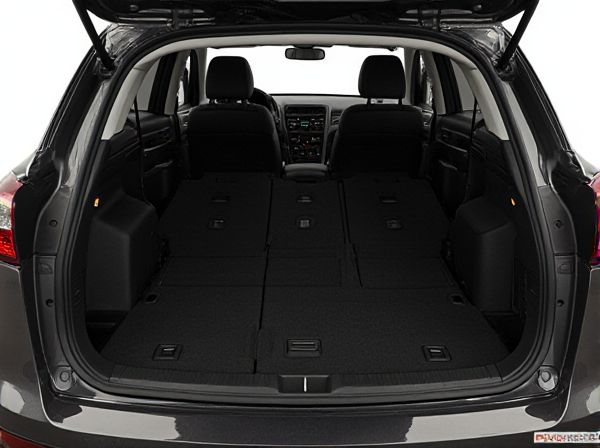
Photo illustration: Split-Folding Rear Seat vs Non-Folding Rear Seat
A split-folding rear seat offers increased versatility by allowing you to fold down one section while keeping the other upright, providing a balance between passenger seating and cargo space. Non-folding rear seats limit this flexibility, often restricting how much cargo you can transport without sacrificing passenger comfort. Choosing a split-folding option enhances your vehicle's practicality, especially for carrying larger or irregularly shaped items.
Table of Comparison
| Feature | Split-Folding Rear Seat | Non-Folding Rear Seat |
|---|---|---|
| Trunk Space Flexibility | High - Allows partial expansion by folding one or more seat sections | Low - Trunk space fixed, no expansion into rear cabin |
| Passenger Capacity | Adjustable - Can fold seats while retaining some passenger seating | Fixed - Full rear seating must remain for passenger use |
| Convenience | Enhanced - Easier loading of long or bulky items through fold-down sections | Limited - Requires alternative cargo solutions for oversized items |
| Typical Use Cases | Ideal for mixed cargo and passenger needs | Best suited for dedicated passenger seating without cargo expansion |
| Resale Value Impact | Positive - Adds versatility, favored in market | Neutral to Negative - Less flexible configuration |
Introduction to Rear Seat Configurations
Rear seat configurations enhance vehicle versatility and passenger comfort, with split-folding rear seats allowing individual sections to be folded down independently to increase cargo space without compromising seating capacity. Non-folding rear seats maintain a fixed position, limiting cargo flexibility but often providing added structural rigidity and support for passengers. Choosing between split-folding and non-folding rear seats depends on the balance between cargo hauling needs and passenger accommodation requirements in various vehicle models.
What is a Split-Folding Rear Seat?
A split-folding rear seat is a rear car seat design that allows individual sections to fold down independently, typically in a 60/40 or 40/20/40 configuration. This feature enhances versatility by enabling passengers to customize seating and cargo space, accommodating larger items without sacrificing all rear passenger seating. Compared to non-folding rear seats, split-folding seats significantly improve cargo capacity and practicality for transporting both goods and passengers.
Features of Non-Folding Rear Seats
Non-folding rear seats provide a fixed seating arrangement that maximizes structural integrity and comfort with consistent cushioning and support. These seats often include premium upholstery and integrated headrests but lack the versatility found in split-folding designs, limiting cargo expansion options. Designed primarily for passenger comfort, non-folding rear seats are common in vehicles prioritizing ride quality over cargo flexibility.
Cargo Space Flexibility and Utility
Split-folding rear seats offer enhanced cargo space flexibility by allowing one or both sections to fold down independently, accommodating passengers and larger or irregularly shaped items simultaneously. Non-folding rear seats limit utility by restricting cargo capacity to the trunk area only, making it challenging to transport bulky or extended items. Vehicles equipped with split-folding seats provide a versatile interior layout that maximizes usability for varied lifestyle and cargo needs.
Passenger Comfort and Accessibility
A split-folding rear seat enhances passenger comfort by allowing customizable seating arrangements and increased legroom, adapting to both passengers and cargo needs more effectively than a non-folding rear seat. It provides superior accessibility by enabling partial seat folds for easy entry to the rear cabin or extended trunk space without displacing all passengers. In contrast, a non-folding rear seat restricts flexibility, limiting comfort adjustments and reducing overall cabin versatility for varying passenger and cargo scenarios.
Impact on Vehicle Interior Design
Split-folding rear seats enhance vehicle interior design by providing versatile cargo and passenger configurations, allowing users to maximize space utilization without compromising comfort. Non-folding rear seats limit interior adaptability, resulting in fixed seating arrangements that reduce practicality for transporting larger items. The inclusion of split-folding seats often integrates innovative hinge mechanisms and structural reinforcements, influencing overall interior layout and material choices.
Safety Considerations for Rear Seats
Split-folding rear seats enhance safety by allowing passengers to securely adjust seating configurations without compromising seatbelt integrity or airbag deployment. Non-folding rear seats provide a rigid, fixed structure that may offer consistent protection during collisions, but lack flexibility for securing larger cargo safely. Properly designed split-folding seats include reinforced latching mechanisms to prevent seat collapse, maintaining occupant protection in crash scenarios.
Common Applications in Different Vehicle Types
Split-folding rear seats enhance versatility in SUVs and hatchbacks by allowing partial seat folding to expand cargo space while retaining passenger seating. Non-folding rear seats are typically found in compact sedans and coupes, prioritizing structural rigidity and passenger comfort over cargo flexibility. Vehicles designed for family use or outdoor activities often incorporate split-folding designs to accommodate various passenger and cargo combinations.
Maintenance and Durability Concerns
Split-folding rear seats often feature more complex mechanisms and joints, which may require regular lubrication and inspection to prevent wear and ensure smooth operation, potentially increasing maintenance needs compared to non-folding rear seats. Non-folding rear seats generally have fewer moving parts, making them more durable over time due to reduced risk of mechanical failure and less frequent maintenance. Choosing between the two depends on balancing the versatility of split-folding seats with the lower upkeep and long-term durability of fixed rear seats.
Choosing the Right Rear Seat for Your Needs
Choosing between a Split-Folding Rear Seat and a Non-Folding Rear Seat depends on your need for versatility and cargo space. Split-Folding Rear Seats offer the flexibility to expand trunk capacity by folding down one or both seat sections separately, ideal for transporting larger items without sacrificing passenger space. Non-Folding Rear Seats provide a fixed backrest, offering more structural rigidity and potentially better comfort but less adaptability for varying cargo sizes.
 caratoz.com
caratoz.com